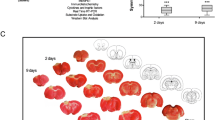Abstract
Focal cerebral ischemia in the rat was induced by left middle cerebral artery occlusion. The area of ischemia was determined by infusion of a qualitative perfusion indicator, neutral red. The temporal evolution of alterations in regional energy metabolism was assessed by direct microquantitative histochemical analysis of high-energy phosphates, glucose, glycogen, and lactate content of the tissue. Perfusion analyses demonstrated a perifocal region of diminished, but not absent perfusion up to 6 hr after occlusion. By 24 hr, there was an abrupt demarcation between perfused and nonperfused regions. Profound metabolic alterations were seen as early as 20 min after occlusion. Although there was an area of intermediate metabolic derangement in the more medial portions of the lateral ipsilateral cortex up to 6 hr, by 24 hr there was an abrupt transition from normal to abnormal cortex. No evidence of metabolic recovery was seen in this model of permanent occlusion.
Similar content being viewed by others
References
Arai, H., Lust, W. D., and Passonneau, J. V. (1982). Delayed metabolic changes induced by 5 min of ischemia in the gerbil brain.Trans. Am. Soc. Neurochem. 13: 177–180.
Brint, S., Jacewicz, M., Kiessling, M., Tanabe, J., and Pulsinelli, W. (1988). Focal brain ischemia in the rat: Methods for reproducible neocortical infarction using tandem occlusion of the distal middle cerebral and ipsilateral common carotid arteries.J. Cereb. Blood Flow Met. 8: 474–485.
Coyle, P. (1986). Different susceptibilities to cerebral infarction in spontaneously hypertensive (SHR) and normotensive Sprague-Dawley rats.Stroke 17: 520–525.
Duverger, D., and MacKenzie, E. T. (1988). The quantification of cerebral infarction following focal ischemia in the rat: Influence of strain, arterial pressure, blood glucose concentration, and age.J. Cereb. Blood Flow Metab. 8: 449–461.
Garcia, J. H. (1984). Experimental ischemic stroke. A review.Stroke 15: 5–14.
Germano, I., Pitts, L. H., Berry, I., and DeArmond, S. J. (1988). High energy phosphate metabolism in experimental permanent focal cerebral ischemia: An in vivo [31]P magnetic resonance spectroscopy study.J. Cereb. Blood Flow Metab. 8: 24–31.
Germano, I. M., Pitts, L. H., Berry, I., and Moseley, M. (1989). Magnetic resonance imaging and [31]P magnetic resonance spectroscopy for evaluating focal cerebral ischemia.J. Neurosurg. 70: 612–618.
James, T. L. (1984). In vivo nuclear magnetic resonance spectroscopy. In Moss, A. A., Ring, E. J., and Higgins, C. B. (eds.),NMR, CT, and Interventional Radiology, Department of Radiology, University of California, San Francisco, pp. 235–244.
Klatzo, I., Farkas-Bargeton, E., Guth, L., Miguel, J., and Olsson, Y. (1970). Some morphological and biochemical aspects of abnormal glycogen accumulation in the glia. InSixth International Congress of Neuropathology, Masson et Cie, Paris, pp. 351–365.
Kobayashi, M., Lust, W. D., and Passonneau, J. V. (1977). Concentrations of energy metabolites and cyclic nucleotides during and after bilateral ischemia in the gerbil cerebral cortex.J. Neurochem. 29: 53–59.
Konig, J. F. R., and Klippel, R. A. (1963).The Rat Brain: A Stereotaxic Atlas of the Forebrain and Lower Parts of the Stem, Kreiger, New York.
Ljunggren, B., Ratcheson, R. A., and Siesjo, B. K. (1974). Cerebral metabolic state following complete compression ischaemia.Brain Res. 73: 291–307.
Lowry, O. H., and Passonneau, J. V. (1972).A Flexible System of Enzymatic Analysis, Academic Press, New York.
Lust, W. D., Feussner, G. K., Barbehenn, E. K., and Passonneau, J. V. (1981). The enzymatic measurement of adenine nucleotides and P-creatine in picomole amounts.Anal. Biochem. 110: 258–266.
Lust, W. D., Ricci, A. J., Selman, W. R., and Ratcheson, R. A. (1989). Methods of fixation of nervous tissue for use in the study of cerebral energy metabolism. In Boulton, A. A., Baker, G. B., and Butterworth, R. F. (eds.),Neuromethods, Vol. 11. Carbohydrates and Energy Metabolism, Humana Press, Clifton, N.J.
Meyer, J. S., Itoh, Y., Okamato, S., Welch, K. M. A., Mathew, N. T., Ott, E. O., Sakaki, S., Miyakawa, Y., Chahi, E., and Ericsson, A. D. (1975). Circulatory and metabolic effects of glycerol infusion in patients with recent cerebral infarction.Circulation 52: 701–712.
Nedergaard, M., Gjeddee, A., and Diemer, N. H. (1986). Focal ischemia of the rat brain: Autoradiographic determination of cerebral glucose utilization, glucose content, and blood flow.J. Cereb. Blood Flow Metab. 6: 414–424.
Nowicki, J.-P., Assumel-Lurdin, C., Duverger, D., and MacKenzie, E. T. (1988). Temporal evolution of regional energy metabolism following focal cerebral ischemia in the rat.J. Cereb. Blood Flow Metab. 8: 462–473.
Ponten, U., Ratcheson, R. A., Salford, L. G., and Siesjö, B. K. (1973). Optimal freezing conditions for cerebral metabolites in rats.J. Neurochem. 21: 1127–1138.
Ratcheson, R. A., and Ferrendelli, J. A. (1980). Regional cortical metabolism in focal ischemia.J. Neurosurg. 52: 755–763.
Selman, W. R., LaManna, J. C., Ricci, A. J., Crumrine, R. C., Lust, W. D., and Ratcheson, R. A. (1987a). Evolution of ischemic brain damage following middle cerebral artery occlusion in the rat.J. Cereb. Blood Flow Metab. 7 (Suppl. 1): 12–20.
Selman, W. R., VanDerVeer, C., Wittingham, T. S., LaManna, J. C., Lust, D., and Ratcheson, R. A. (1987b). Visually defined zones of focal ischemia in the rat brain.Neurosurgery 21: 825–830.
Siesjö, B. K. (1978).Brain Energy Metabolism, John Wiley, Chichester, U.K.
Tamura, A., Graham, D. I., McCulloch, J., and Teasdale, G. M. (1981). Description of technique and early neuropathological consequences following middle cerebral artery occlusion.J. Cereb. Blood Flow Metab. 1: 53–60.
Weinstein, P. R., Anderson, D. G., and Telles, D. A. (1986). Neurological deficit and cerebral infarction after temporary middle cerebral artery occlusion in unanesthetized cats.Stroke 17: 318–324.
Welsh, F. A. (1984). Regional evaluation of ischemic metabolic alterations.J. Cereb. Blood Flow Metab 4: 309–316.
Author information
Authors and Affiliations
Rights and permissions
About this article
Cite this article
Selman, W.R., Ricci, A.J., Crumrine, R.C. et al. The evolution of focal ischemic damage: A metabolic analysis. Metab Brain Dis 5, 33–44 (1990). https://doi.org/10.1007/BF00996976
Received:
Accepted:
Issue Date:
DOI: https://doi.org/10.1007/BF00996976



